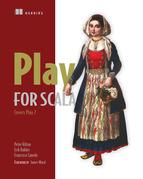List of Listings
Chapter 1. Introduction to Play 2
Listing 1.1. Command-line output when you create a new Play application
Listing 1.2. Command-line output when you run the application
Chapter 2. Your first Play application
Listing 2.1. Override Twitter Bootstrap—public/stylesheets/main.css
Listing 2.6. The model—app/models/Product.scala
Listing 2.7. The list page template—app/views/products/list.scala.html
Listing 2.8. The layout template—app/views/main.scala.html
Listing 2.9. The products controller—app/controllers/Products.scala
Listing 2.10. Routes configuration file—conf/routes
Listing 2.11. The default controller—app/controllers/Application.scala
Listing 2.12. Debug information template—app/views/debug.scala.html
Listing 2.13. Page footer to the layout template—app/views/main.scala.html
Listing 2.14. Product-details—app/views/products/details.scala.html
Listing 2.15. The bar code tag—app/views/tags/barcode.scala.html
Listing 2.16. Additional details page messages—conf/messages
Listing 2.17. Additional details page messages—conf/messages.es
Listing 2.18. Additional details page messages—conf/messages.fr
Listing 2.19. Additional details page messages—conf/messages.nl
Listing 2.20. Details page controller action—app/controllers/Products.scala
Listing 2.21. Details page route—conf/routes
Listing 2.22. Barcodes controller—app/controllers/Barcodes.scala
Listing 2.24. conf/messages.es
Listing 2.25. conf/messages.fr
Listing 2.26. conf/messages.nl
Listing 2.27. Product form—app/controllers/Products.scala
Listing 2.28. New main template—app/views/main.scala.html
Listing 2.29. Add product button—app/views/products/list.scala.html
Listing 2.30. New-product—app/views/products/editProduct.scala.html
Listing 2.31. Save a new product—app/models/Product.scala
Listing 2.32. Validate and save—app/controllers/Products.scala
Listing 2.33. Validate and save 2—app/controllers/Products.scala
Listing 2.34. New-product action—app/controllers/Products.scala
Chapter 3. Deconstructing Play application architecture
Listing 3.1. Initial minimal configuration file—conf/application.conf
Listing 3.2. Using the Play API to retrieve the current application’s configuration
Listing 3.3. Accessing a subconfiguration
Listing 3.4. Domain model classes—app/models/models.scala
Listing 3.5. A minimal HTML document—app/views/minimal.scala.html
Listing 3.6. Template with a title parameter—app/views/title.scala.html
Listing 3.7. Compiled template title.template.scala
Listing 3.8. Pick list template—app/views/pickList.scala.html
Listing 3.9. Pick list controller—app/controllers/PickLists.scala
Listing 3.10. Pick list controller—app/controllers/PickLists.scala
Listing 3.11. Global settings object—app/Global.scala
Listing 3.12. Pick list generation actor—app/Global.scala
Listing 3.13. Suspend an HTTP request—app/controllers/Dashboard.scala
Chapter 4. Defining the application’s HTTP interface
Listing 4.1. A controller class with four action methods
Listing 4.2. Servlet API method to handle a request with a numeric parameter
Listing 4.3. Bar code controller action—app/controllers/Products.scala
Chapter 5. Storing data—the persistence layer
Listing 5.3. Convert the query results to entities
Listing 5.4. Use a pattern to convert query results
Listing 5.6. Products with stock items
Listing 5.7. Inserting records
Listing 5.8. Update and delete
Listing 5.9. Initialize Squeryl
Listing 5.11. Define the schema
Listing 5.12. Idiomatic schema
Chapter 6. Building a user interface with view templates
Listing 6.1. Play 1 Groovy template
Listing 6.2. Play 1.x with Java controller example
Listing 6.3. Play 1.x Groovy template
Listing 6.4. Play 2 Scala template
Listing 6.5. Play 2 with Scala controller example
Listing 6.6. Full HTML for the catalog page
Listing 6.7. Catalog page with navigation extracted
Listing 6.8. Extracted page layout
Listing 6.9. The extracted main template
Listing 6.10. Refactored catalog template
Listing 6.11. Extracted product list
Chapter 7. Validating and processing input with the forms API
Listing 7.1. Play 1.x example: User creation HTML form
Listing 7.2. Play 2 Form to validate a request from the HTML form of listing 7.1
Listing 7.3. Add Product form simplified HTML
Listing 7.4. Action method create, which tries to bind the form from the request
Listing 7.5. Template that uses form helpers to generate an HTML form
Listing 7.6. HTML generated by form helpers for the product form
Listing 7.7. Product form with validation errors and old values
Listing 7.8. Field with custom class and attribute
Listing 7.9. FieldConstructor for Twitter bootstrap
Listing 7.10. The bootstrap package object with an implicit FieldConstructor
Listing 7.11. Product form using custom FieldConstructor
Listing 7.12. Form with validation on multiple fields
Listing 7.13. Inline nested forms
Listing 7.14. Definition of Play’s Formatter trait
Listing 7.15. LocalDate formatter
Listing 7.17. Using the ignored mapping and custom validation to validate file uploads
Chapter 8. Building a single-page JavaScript application with JSON
Listing 8.1. Override Twitter Bootstrap—public/stylesheets/main.css
Listing 8.2. The model—app/models/Product.scala
Listing 8.3. The application’s single-page template—app/views/index.scala.html
Listing 8.4. list action returns a JSON array—app/controllers/Products.scala
Listing 8.5. HTTP routes configuration—conf/routes
Listing 8.6. Nested JSON structure constructed from JSON library case classes
Listing 8.7. HTML table element data placeholder—app/views/index.scala.html
Listing 8.8. Client application to load data from the server—products.coffee
Listing 8.9. Desired output—JSON representation of a Product object
Listing 8.10. Output product details in JSON format—app/controllers/Products.scala
Listing 8.11. Writes[Product] implementation
Listing 8.12. Writes[Product] implementation using JsPath
Listing 8.13. Alternative Writes[Product] that exposes purchase_price
Listing 8.14. HTML table element data placeholder—app/views/index.scala.html
Listing 8.15. Client that adds product details to each row—products.coffee
Listing 8.16. Make the table editable and update via the server—products.coffee
Listing 8.17. Controller action to save product details—Products.scala
Listing 8.18. Reads[Product] implementation
Listing 8.19. Reads[Product] implementation
Listing 8.20. Format[Product] implementation
Listing 8.21. Sample product JSON structure
Listing 8.22. Corresponding model class structure
Listing 8.23. JSON parser definitions
Listing 8.24. Reads[Company] and Reads[Product] with validation rules
Listing 8.25. Controller action to validate and save product details—Products.scala
Listing 8.26. Formatting JSON validation errors for a JSON response
Listing 8.27. Action helper that performs authentication
Listing 8.28. Helper function to extract credentials from a request query string
Listing 8.29. Updated action helper that extracts credentials before authentication
Listing 8.30. Helper function to extract credentials from basic authentication headers
Chapter 9. Play and more
Listing 9.1. The build properties—Build.scala
Listing 9.2. UserService—app/utils/SimpleUserService.scala
Listing 9.3. Controller—app/com/github/playforscala/barcodes/Barcodes.scala
Listing 9.4. Bar code template—app/views/index.scala.html
Listing 9.5. project/Build.scala
Listing 9.6. app/com/github/playforscala/barcodes/BarcodeCache.scala
Listing 9.7. app/com/github/playforscala/barcodes/Barcodes.scala
Listing 9.8. app/com/github/playforscala/barcodes/
Listing 9.9. .../playforscala/barcodes/BarcodesPlugin.scala
Listing 9.10. HAProxy configuration
Listing 9.11. Apache front-end proxy configuration
Listing 9.12. Apache front-end proxy and load-balancing configuration
Chapter 10. Web services, iteratees, and WebSockets
Listing 10.1. tweetList action
Listing 10.2. Tweetlist template
Listing 10.3. Completed Twitter API action method
Listing 10.4. Caching an entire action
Listing 10.5. Signing a request with OAuth
Listing 10.6. Using Twitter’s streaming API with a simple logging iteratee
Listing 10.7. Status page HTML and JavaScript
Listing 10.8. WebSocket action that sends load average every three seconds
Listing 10.9. Unsafe: mutable state defined on the controller
Listing 10.10. Chat application room actor
Listing 10.11. Chat controller
Listing 10.12. Chatroom HTML page
Listing 10.13. Amazon S3 uploading body parser, buildRequest method
